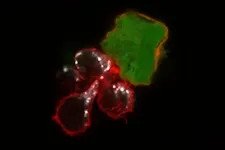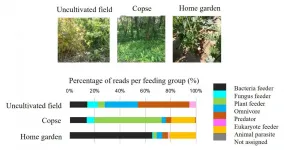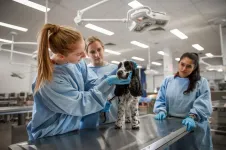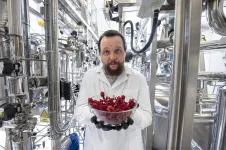INFORMATION:
To read the full study, go to the Astrophysical Journal Letters website: https://iopscience.iop.org/article/10.3847/2041-8213/ac082e.
Scientists detect gravitational waves for first time from black holes swallowing neutron stars
RIT researchers from the LIGO Scientific Collaboration helped detect the rare events
2021-06-29
(Press-News.org) For the first time, scientists detected gravitational waves caused by mergers between black holes and neutron stars. Researchers from LIGO, Virgo, and KAGRA detected the two gravitational wave events--from distances of more than 900 million light-years away--within a span of 10 days in January 2020 during the second half of LIGO and Virgo's third observing run. Astrophysical Journal Letters published the results and their implications today: https://iopscience.iop.org/article/10.3847/2041-8213/ac082e.
Researchers from Rochester Institute of Technology's Center for Computational Relativity and Gravitation (CCRG) helped identify key characteristics about the merger events. Anjali Yelikar, an astrophysical sciences and technology Ph.D. student from India, was among those heavily involved in the findings. She used parameter estimation code developed by Associate Professor Richard O'Shaughnessy and alumnus Jacob Lange '18 MS (astrophysical sciences and technology), '20 Ph.D. (astrophysical sciences and technology) to find the mass, spin, distance from Earth, and position in the sky of the black holes and neutron stars involved.
"It's a real dream come true to be a part of a discovery like this," said Yelikar. "I was an undergraduate student when LIGO announced the first gravitational wave detection in 2016. It's amazing to see how far the science has come and I am excited to see what new developments await as the scientific community develops more sensitive detectors."
The yearlong third observing run was cut short by a month due to the coronavirus pandemic in March 2020 and the fourth is expected to begin in the summer of 2022, bringing more advanced detectors to the fold. Two main theories suggest how neutron stars and black holes could merge--one starting with two stars already orbiting each other and the other starting with unrelated supernova explosions--and while the mergers announced today offer hints about their origins, scientists hope to find more confirmation in subsequent observing runs.
"These elusive systems have long been missing from astronomers' family portrait of compact binaries," said O'Shaughnessy. "Now that we see the whole family, we can use this portrait to try to understand their relationships and lineage. For example, at least one of the neutron stars in these objects is relatively big, compared to neutron stars found before. That may be a clue into how cosmic explosions work and how these objects form."
Scientists did not observe electromagnetic wave counterparts to the gravitational waves caused by the events despite follow-up observations from multiple observatories. However, that is also something scientists will hunt for during future observing runs.
"This discovery is very exciting, not only because it confirms the existence of black-hole-neutron-star binaries, but also because such binaries are potential sources of extremely intense gamma-ray bursts," said Yosef Zlochower, an associate professor in the School of Mathematical Sciences who develops simulations used to compare against gravitational wave signals. "This leads to the real possibility of future combined gravitational-wave and electromagnetic observations of these sources."
Professor John Whelan, principal investigator of RIT's group in the LIGO Scientific Community, said, "With this observation of gravitational waves from yet another type of astrophysical system, the LIGO, Virgo and now KAGRA collaborations continue to broaden the field of gravitational wave astronomy. We look forward to further discoveries as we analyze data from this and future observing runs."
ELSE PRESS RELEASES FROM THIS DATE:
LSL60101 compound reduces neuroinflammation and improves cognition
2021-06-29
The LSL60101 compound, a specific ligand of the I2-IR receptors in the brain, could shed light on the development of future strategies against Alzheimer's disease. This is stated in the recent studies by the Research Group on Medicinal Chemistry and Pharmacology of Neurodegenerative Diseases of the University of Barcelona, published in the journals European Journal of Medicinal Chemistry and British Journal Pharmacology. In studies carried out with mice, LSL60101 has improved the cognitive deficit and the biomarkers related to the disease in these animal models.
These studies result from the collaboration of the research teams led by professors Carmen Escolano, from the Faculty of Pharmacy and Food Sciences and the Institute of Biomedicine of the UB ...
Just enough information will motivate young children to learn, drive curiosity
2021-06-29
Preschool children are sensitive to the gap between how much they know and how much there is to learn, according to a Rutgers University-New Brunswick study.
The research, published in the journal END ...
Mongoose in the city: How landscape can impact disease transmission in Botswana
2021-06-29
Under a concrete drainage culvert at the edge of a town in Botswana, a troop of banded mongoose is getting ready to leave its den. Moving from shade into light, the cat-sized animals scan the area for signs of danger and for opportunities to find something to eat in an increasingly crowded neighborhood.
Unbeknownst to them, the genetics of this troop's members -- and others like them -- are providing researchers in the College of Natural Resources and Environment with new understandings of how and why animal behavior changes in proximity to human development and how that change can impact infectious disease spread.
The researchers used genetic tools to identify changes in movement behavior among mongooses ...
Cell-based immunotherapy shows promise against melanoma
2021-06-29
An immunotherapy based on supercharging the immune system's natural killer cells has been effective in treating patients with recurrent leukemia and other difficult to treat blood cancers. Now, researchers at Washington University School of Medicine in St. Louis have shown in preclinical studies conducted in mice and human cells that this type of cell-based immunotherapy also could be effective against solid tumors, starting with melanoma, a type of skin cancer that can be deadly if not caught early.
The study is published June 29 in Clinical Cancer Research, ...
AAFP releases updated feline senior care guidelines to the veterinary community
2021-06-29
[BRIDGEWATER, NJ; June 29, 2021] The American Association of Feline Practitioners (AAFP) has released the updated 2021 AAFP Feline Senior Care Guidelines to be published in the July issue of the Journal of Feline Medicine and Surgery. This update provides emerging advances in feline medicine with respect to the aging cat. The Task Force of experts provides a thorough current review in feline medicine that emphasizes the individual senior patient.
As defined in the 2021 AAHA/AAFP Feline Life Stage Guidelines, cats over 10 years of age are considered to be 'senior.' Understanding the changing needs of each individual senior cat is critical for both veterinary professionals and cat owners. "Veterinary professionals are encouraged to use the 2021 ...
A world first! Visualizing atomic-scale structures with the optical force
2021-06-29
Osaka, Japan - A team of scientists led by the Department of Applied Physics at Osaka University, the Department of Physics and Electronics at Osaka Prefecture University, and the Department of Materials Chemistry at Nagoya University used photoinduced force microscopy to map out the forces acting on quantum dots in three dimensions. By eliminating sources of noise, the team was able to achieve subnanometer precision for the first time ever, which may lead to new advances in photocatalysts and optical tweezers.
Force fields are not the invisible barriers of science fiction but are a set of vectors indicating the magnitude and direction of forces acting in a region ...
DNA barcodes decode the world of soil nematodes
2021-06-29
Overview
The research team of Professor Toshihiko Eki of the Department of Applied Chemistry and Life Science (and Research Center for Agrotechnology and Biotechnology), Toyohashi University of Technology used a next-generation sequencer to develop a highly efficient method to analyze soil nematodes by using the 18S ribosomal RNA gene regions as DNA barcodes. They successfully used this method to reveal characteristics of nematode communities that inhabit fields, copses, and home gardens. In the future, the target will be expanded to cover all soil-dwelling organisms in agricultural soils, etc., to allow investigations into a soil's environment and bio-diversity. This is expected to contribute to advanced agriculture.
Details
Similar to when the ...
What makes vets feel good at work?
2021-06-29
Receiving a simple thank you, spending time with peers and further developing their expertise, are all factors that make veterinarians feel good at work, according to a new study by researchers at the University of Adelaide.
In the study published by Vet Record, researchers investigated the positive side of veterinary work and specifically what brings vets pleasure in their job.
Lead author Madeleine Clise, a psychologist and Adjunct Lecturer at the University of Adelaide's School of Psychology says: "At a time in Australia when there are national shortages of vets, particularly in regional areas, and increased publicity about the ...
To adsorb or to do not adsorb? That is the question
2021-06-29
Prolonged exposure to antibiotics leads to the gain of bacteria's ability to defeat the drugs designed to fight them. Thus, if such antibiotic-resistant bacteria cause the infection, the only chance to use a specialized virus called phage infecting specific bacteria species. It is a powerful weapon against deadly diseases. At the same time, the effective treatment depends on factors that would not be suspected for years to impact the successful therapy. Recently, researchers from the Institute of Physical Chemistry, Polish Academy of Sciences led by dr. Jan Paczesny and Professor ...
Using artificial intelligence to overcome mental health stigma
2021-06-29
Tsukuba, Japan - Depression is a worldwide problem, with serious consequences for individual health and the economy, and rapid and effective screening tools are thus urgently needed to counteract its increasing prevalence. Now, researchers from Japan have found that artificial intelligence (AI) can be used to detect signs of depression.
In a study published this month in BMJ Open, researchers from University of Tsukuba have revealed that an AI system using machine learning could predict psychological distress among workers, which is a risk factor for depression. ...
LAST 30 PRESS RELEASES:
Tracing the quick synthesis of an industrially important catalyst
New software sheds light on cancer’s hidden genetic networks
UT Health San Antonio awarded $3 million in CPRIT grants to bolster cancer research and prevention efforts in South Texas
Third symposium spotlights global challenge of new contaminants in China’s fight against pollution
From straw to soil harmony: International team reveals how biochar supercharges carbon-smart farming
Myeloma: How AI is redrawing the map of cancer care
Manhattan E. Charurat, Ph.D., MHS invested as the Homer and Martha Gudelsky Distinguished Professor in Medicine at the University of Maryland School of Medicine
Insilico Medicine’s Pharma.AI Q4 Winter Launch Recap: Revolutionizing drug discovery with cutting-edge AI innovations, accelerating the path to pharmaceutical superintelligence
Nanoplastics have diet-dependent impacts on digestive system health
Brain neuron death occurs throughout life and increases with age, a natural human protein drug may halt neuron death in Alzheimer’s disease
SPIE and CLP announce the recipients of the 2025 Advanced Photonics Young Innovator Award
Lessons from the Caldor Fire’s Christmas Valley ‘Miracle’
Ant societies rose by trading individual protection for collective power
Research reveals how ancient viral DNA shapes early embryonic development
A molecular gatekeeper that controls protein synthesis
New ‘cloaking device’ concept to shield sensitive tech from magnetic fields
Researchers show impact of mountain building and climate change on alpine biodiversity
Study models the transition from Neanderthals to modern humans in Europe
University of Phoenix College of Doctoral Studies releases white paper on AI-driven skilling to reduce burnout and restore worker autonomy
AIs fail at the game of visual “telephone”
The levers for a sustainable food system
Potential changes in US homelessness by ending federal support for housing first programs
Vulnerability of large language models to prompt injection when providing medical advice
Researchers develop new system for high-energy-density, long-life, multi-electron transfer bromine-based flow batteries
Ending federal support for housing first programs could increase U.S. homelessness by 5% in one year, new JAMA study finds
New research uncovers molecular ‘safety switch’ shielding cancers from immune attack
Bacteria resisting viral infection can still sink carbon to ocean floor
Younger biological age may increase depression risk in older women during COVID-19
Bharat Innovates 2026 National Basecamp Showcases India’s Most Promising Deep-Tech Ventures
Here’s what determines whether your income level rises or falls
[Press-News.org] Scientists detect gravitational waves for first time from black holes swallowing neutron starsRIT researchers from the LIGO Scientific Collaboration helped detect the rare events






